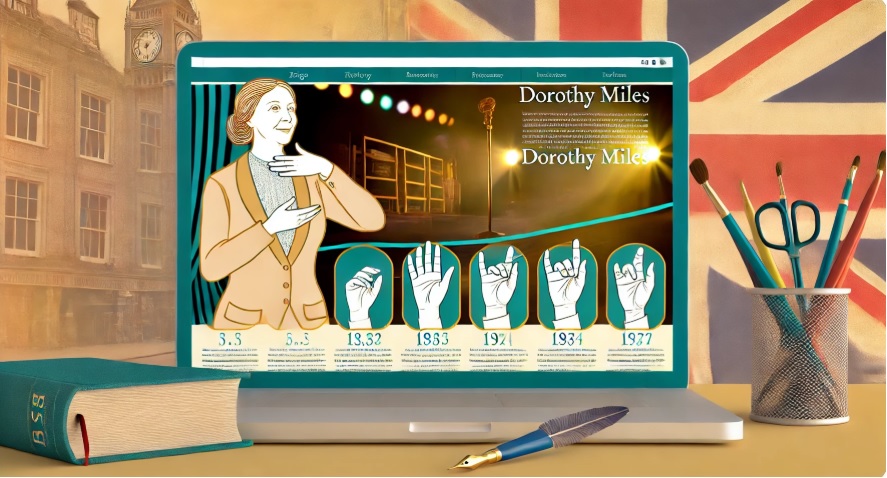The Legacy of Dorothy Miles: A Deep Dive into the History of British Sign Language

British Sign Language (BSL) stands as a beacon of communication for the deaf community in the UK, carrying a rich tapestry of history and evolution. Among the pivotal figures in this journey, Dorothy Miles shines as a significant contributor and cultural icon. Her endeavors have left an indelible mark on the development and recognition of BSL. This article explores the fascinating historical landscape of British Sign Language, spotlighting Dorothy Miles’ influential role and the milestones that have shaped its current status.
The Genesis of British Sign Language
The history of British Sign Language is complex and storied, with its roots tracing back several centuries. Originally evolving from homegrown signs and regional dialects, BSL found its formal stride in the 18th century. The first documented school for the deaf, established in 1760 by Thomas Braidwood, marked a pivotal moment in BSL’s history. Braidwood’s methods incorporated a unique blend of manual communication, which significantly influenced BSL’s structure.
Dorothy Miles and Her Impact
Dorothy Miles, an American-born poet and activist, moved to the UK and became instrumental in promoting the recognition and acceptance of BSL. Her creative expressions through sign language poetry and performance brought a new dimension to BSL, infusing it with artistic and emotional depth. Miles’ work not only elevated the status of sign language in the arts but also fostered greater awareness and appreciation within the wider public and deaf communities alike.
Key Milestones in BSL Recognition
One of the major milestones in the history of British Sign Language came in the late 20th century. In 1975, the British Deaf Association initiated the BSL project, aiming to standardize and promote BSL as an independent language. This effort culminated in the official recognition of BSL as a language in its own right by the UK government in 2003. This recognition was a crucial step forward in advocating for the rights and cultural identity of the deaf community.
Regional Variations in BSL
BSL, like any living language, exhibits regional variations, which reflect the rich linguistic tapestry of the UK. These variations, known as ‘dialects’ within the deaf community, add to the complexity and vibrancy of BSL. The term given for these differences is “regional sign variants,” and they highlight the diverse cultural and linguistic heritage that BSL represents across different areas of the UK.
BSL and Its Educational Framework
The educational impact of BSL has been profound. With the establishment of schools for the deaf and the integration of BSL into educational curricula, there has been a significant enhancement in the learning and communication avenues available to deaf students. The history of British Sign Language timeline in education reflects a growing inclusivity and adaptation of teaching methods tailored to the needs of the deaf community.
Comparative Analysis: BSL vs. ASL
Comparing British Sign Language with American Sign Language (ASL) reveals interesting distinctions and similarities. While both languages share a common base in historical sign languages, they have evolved independently to form distinct linguistic systems. This comparison not only highlights the uniqueness of each language but also the global diversity of sign languages.
The Continued Evolution of BSL
The journey of BSL is ongoing, with technological advancements and societal changes continually shaping its usage and development. Today, BSL is not only a means of communication but also a subject of academic and cultural study, reflecting its established status in the linguistic landscape of the UK.
Final Words
The history of British Sign Language is a testament to the resilience and adaptability of the deaf community. Dorothy Miles, with her pioneering spirit, has played a crucial role in this narrative, bringing both visibility and respect to BSL. As we look to the future, the legacy of BSL continues to grow, supported by ongoing advocacy and education.
FAQs
- Who invented British Sign Language?
British Sign Language evolved organically over time through the contributions of many individuals and institutions, with no single inventor. - When was British Sign Language officially recognised?
BSL was officially recognised by the UK government as a language in its own right in 2003. - What is the term given for the difference in BSL signs found within different areas of the UK?
These are commonly referred to as “regional sign variants.” - How does British Sign Language differ from American Sign Language?
While both have historical roots in sign language used in the 18th and 19th centuries, they have developed distinct grammatical structures and vocabularies. - What are key milestones in the history of sign language?
Key milestones include the establishment of the first school for the deaf in 1760 and the official recognition of BSL as a language in 2003.





